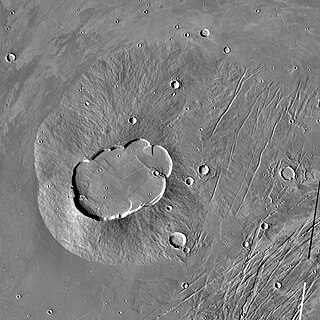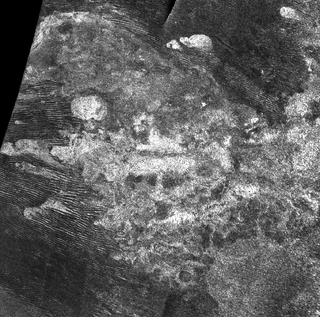Mons on Venus
 Abeona Mons | |
| Feature type | Mountain |
|---|---|
| Coordinates | 44°48′S273°06′E / 44.8°S 273.1°E / -44.8; 273.1 [1] |
| Diameter | 375 km |
| Eponym | Abeona |
Abeona Mons is a mountain on Venus named after Abeona the Roman goddess of travelers. [2]
 Abeona Mons | |
| Feature type | Mountain |
|---|---|
| Coordinates | 44°48′S273°06′E / 44.8°S 273.1°E [1] |
| Diameter | 375 km |
| Eponym | Abeona |
Abeona Mons is a mountain on Venus named after Abeona the Roman goddess of travelers. [2]

Mons Hadley is a massif in the northern portion of the Montes Apenninus, a range in the northern hemisphere of the Moon. It has a height of 4.5 km (2.8 mi) 14,764 ft (4,500 m) above the adjacent plain and a maximum diameter of 25 km at the base.

Beta Regio is a region of the planet Venus known as a volcanic rise. Measuring about 3,000 kilometres in extent, it constitutes a prominent upland region of Venus centered at 25.3°N 282.8°E.
Theia Mons is a large highland shield volcano on the planet Venus. Located near the center of Beta Regio, a large region of recent volcanic uplift due to a currently active mantle plume, Theia Mons is situated at the junction of three branches of Devana Chasma, an extensive rift system. It is named after Theia, a Titan from Greek mythology; the name Theia Mons was officially approved by the International Astronomical Union (IAU) in 1979.

Estan Patera is a patera, or a complex crater with scalloped edges, on Jupiter's moon Io. It is 95 kilometers in diameter and located at 21.53°N 87.59°W. It is named after the Hittite sun god Estan. Its name was adopted by the International Astronomical Union in 2006. It is located at the northern base of the 11-kilometer mountain Gish Bar Mons. Located west-northwest is Skythia Mons, and to the southwest is Monan Mons, at the northern and southern ends of which are Monan Patera and Ah Peku Patera.

Maui Patera is a patera, or a complex crater with scalloped edges, on Jupiter's moon Io. It is about 38 kilometers in diameter and is located at 16.61°N 124.23°W. It is named after Māui, a Hawaiian demigod that sought fire from Mafuike. Its name was approved by the International Astronomical Union in 1979. It is located southwest of the eruptive center Maui, south of Euxine Mons, and southwest of the volcano Amirani. Due east are Monan Patera, Monan Mons, and Ah Peku Patera.

Svarog Patera is a patera, or a complex crater with scalloped edges, on Jupiter's moon Io. It is 124 kilometers in diameter and is located at 48.66°S 265.74°W. It is named after the Russian smith god Svarog. Its name was approved by the International Astronomical Union in 1979. Svarog Patera is a Voyager spacecraft-detected hot spot. North of Svarog Patera is Lyrcea Planum, north of which is Babbar Patera. To the south is Silpium Mons, and to the east is Hermes Mensa. To the southeast are Pyerun Patera and Epaphus Mensa.

Pyerun Patera is a patera, or a complex crater with scalloped edges, on Jupiter's moon Io. It is about 57 kilometers in diameter and is located at 55.65°S 251.06°W. It is named after the Slavonic god of thunder, Pyerun. The name was adopted by the International Astronomical Union in 1985. West of Pyerun Patera is Mithra Patera, and to the east is the mesa Epaphus Mensa. To the northeast is Epaphus Mensa, and to the northwest are the mountain Silpium Mons and Svarog Patera.

Egypt Mons is a mountain on Jupiter's moon Io. It is 10 kilometers in height, making it the 11th tallest mountain on Io, and taller than Mount Everest. Although the U.S. Geological Survey gives a diameter of 193.7 kilometers, the Io Mountain Database gives a length of 133.8 kilometers and a width of 146.0 kilometers. It is a Flatiron Massif mountain, meaning it has a rugged, irregular appearance and complex surface morphology. It is 9792 km2 in area and its center located at 41.49°S 257.6°W. It has a steep, north-facing scarp. Egypt Mons is named for Egypt, because that is the place where Io ended her wanderings in the mythology. Its name was adopted by the International Astronomical Union in 1997. To the northwest is Babbar Patera, and southeast is Hermes Mensa. Svarog Patera can be found to the southwest.

Silpium Mons is a mountain on Jupiter's moon Io. It is 5.6 kilometers in height, 113 kilometers in length, and 79.7 kilometers in width. It covers an area of 7073 km2. It is a striated ridge, meaning it is an elevated structure dominated by one or more prominent linear or arcuate rises. It is named after a location in Greece where the mythological Io died of grief. Its name was adopted by the International Astronomical Union in 1979. It is located at 52.71°S 272.34°W, south of Svarog Patera, north of Mithra Patera, and northeast of Viracocha Patera. Its proximity to Svarog and Viracocha Paterae has been suggested to be evidence for a structural relationship between mountains and calderas on Io.

Apollinaris Mons is an ancient shield volcano in the southern hemisphere of Mars. It is situated near the equator, south of Elysium Planitia and north of the impact crater Gusev. Elysium Planitia separates it from the volcanic province of Elysium to its northwest. The volcano's caldera is named Apollinaris Patera; this name formerly applied to the whole edifice.

The Ceraunius Fossae are a set of fractures in the northern Tharsis region of Mars. They lie directly south of the large volcano Alba Mons and consist of numerous parallel faults and tension cracks that deform the ancient highland crust. In places, younger lava flows cover the fractured terrain, dividing it into several large patches or islands. They are found in the Tharsis quadrangle.

Hrad Vallis is an ancient outflow channel in the Cebrenia quadrangle of Mars, located at 38.7° north latitude and 224.7° west longitude. It is 825 km in length and was named for the word for "Mars" in Armenian.

Tyrrhenus Mons, formerly Tyrrhena Mons or Tyrrhena Patera, is a large volcano in the Mare Tyrrhenum quadrangle of Mars, located at 21.36° south latitude and 253.47° west longitude. The name "Tyrrhena Patera" now refers only to the central depression, a volcanic crater or caldera. It was named after a classical albedo feature name. Pit chains are found at the summit of Tyrrhenus Mons. They are formed by collapse of material into underground voids. Since they form chains and concentric fractures that are aligned, they are probably caused by extension of the surface. Volcanic processes made the crust pull apart. Voids were formed, then material fell into them, leaving holes. It is one of the oldest volcanoes on Mars. As a consequence of its old age, Tyrrhenus Mons has many radiating gullies on its slope. When it was formed, magma may have gone through frozen ground and then erupted as easily eroded ash, instead of lava flows.

Uranius Mons, formerly Uranius Patera, is a volcano on Mars located in the Tharsis quadrangle, named after a classical albedo feature. The name "Uranius Patera" now refers only to the volcano's central caldera. It is 4,853 metres (15,922 ft) high and has shallow slopes. It belongs to the Uranius group of volcanoes in the Tharsis area. The sides of Uranius Mons consist of radial lava flows; the large caldera (90×65 km) is elongated in the southwestern direction. The surrounding plains are younger and part of the Tharsis Montes Formation of the Amazonian epoch.

Arsia Chasmata is a steep-sided depression located northeast of Arsia Mons in the Phoenicis Lacus quadrangle on Mars, located at 7.6° S and 119.3° W. It is 97 km long and was named after an albedo name.

Hesperia Planum is a broad lava plain in the southern highlands of the planet Mars. The plain is notable for its moderate number of impact craters and abundant wrinkle ridges. It is also the location of the ancient volcano Tyrrhena Mons. The Hesperian time period on Mars is named after Hesperia Planum.

Erebor Mons is a mountain on Titan, the largest moon of the planet Saturn. It is located near Titan's equator, between 4–5° south and 35–36° west, centered on 4.97°S 36.23°W, in the western part of Quivira region. It is 40 km across, more than 1 km high, and has lobate flow features to its north and east. It is probably a cryovolcano. Erebor Mons is situated about 470 km to the north-northeast of a larger cryovolcanic construct, Doom Mons.

Skadi Mons is a mountain on Venus in Maxwell Montes, at the center of Ishtar Terra. It is the highest point on the planet, with an altitude of about 10,700 meters above the mean planetary radius.
Idunn Mons is a shield volcano on the planet Venus. It is named after Iðunn, a goddess in Norse mythology.